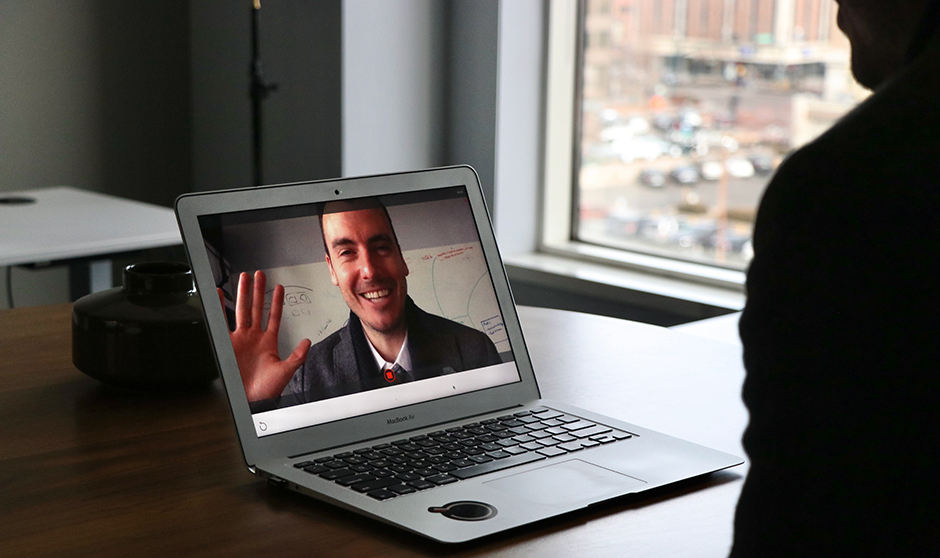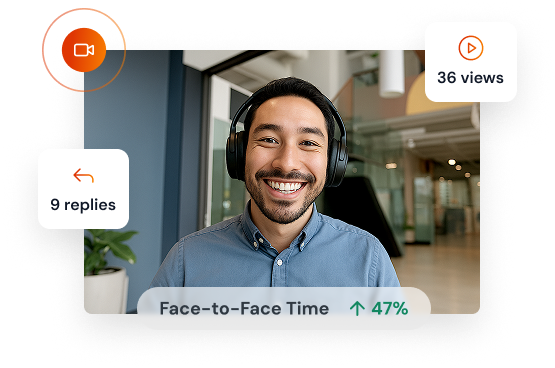Cold calling is hard.
Most people today don’t answer calls from unknown numbers. And if you do get someone to pick up, you have less than 30 seconds to make your pitch.
In this article, we cover what to do before a cold call, what to say once you’re on the line and how to follow up to keep momentum.
With these tactics, cold calling scripts and persistence, you’ll see results immediately. And many of the ideas covered here will help with all types of sales calls.
Additionally, you’ll be able to make fewer calls to generate the same (or better!) results. If you’re someone who worries about how many cold calls you have to make for a sale, this article is for you.
What to Do Before a Cold Call
One of the best ways to increase the likelihood of someone taking your call is to send them a personalized video message first. This could be a video that features only you speaking to the camera or a screen recording.
This tactic brings down a prospect’s guard and prepares them in advance for a cold conversation. People don’t like getting caught off guard or interrupted.
Sending a video first has the potential to eliminate this pain. And it makes your cold call…less cold.
After sending a video, you have two options:
- Follow up shortly after with a phone call
- Wait until your video messaging platform tells you the prospect opened your email or viewed your video
If you go with option #1, mention in your email or message that you are going to follow up by phone. If you get voicemail, mention that you left a personalized video in the person’s inbox.
If you go with option #2, try to follow up as quickly as possible after someone engages. Ideally, your video messaging platform offers real-time alerts so you can capitalize on an opportunity quickly.
Catching someone shortly after they’ve watched your video is slightly better than calling them after they’ve opened your email. With a video view, you at least know the person is able to play audio, which means they likely aren’t in another meeting.
Plus, they’ve had a chance to see your face and hear your voice. Both go a long way towards establishing familiarity early that eventually morphs into trust.
It also makes it harder for someone to reject your call because now they know there is a real, friendly person trying to offer something of value.
While it may seem invasive to call someone so soon after, or even while they’re engaging with your message, it’s actually beneficial in a few ways.
People are already thinking about you and your service. They’re in a better state of mind to hear a pitch.
Prospects don’t linger on the timing. They may wonder initially how you knew they were reading your email or watching your video. But that worry quickly fades once you get into a conversation.
Something else to keep in mind is that this strategy works well for re-engaging leads who have gone cold. Reach out with something of value and show the recipient you’d still love to connect.
If you want to read our in-depth article on the topic of video prospecting, click here.
Pre-Cold Call Best Practices
Here are some quick best practices for these videos:
- Smile: nothing feels as good to us or warms prospects like a sincere smile
- Don’t script your videos: talk to people as if you’re across the table from them
- Include text in your emails or messages: sending a video only can look spammy
- Take advantage of animated previews: if your video messaging tool automatically creates GIFs or animated previews, use this to your advantage.
- Study your analytics: focus on prospects who you know are watching your videos and reading your emails
How to Keep an Initial Appointment
If you’re able to get a prospect to engage and book a scheduled call from your video outreach, great. A great way to make sure that meeting holds is by sending a confirmation over another video message.
This could be a simple video that confirms your meeting in advance and explains what value the prospect should expect to get out of the meeting.
Here’s a sample script:
“Hi Katie, this is Alexa! I hope your morning is going well and I’m looking forward to meeting you today at 1pm at Peak Coffee Shop. I’m hoping I can help you with everything you need today and I’ll see you soon!”
You can even send a few of these reminder videos, one a few days in advance and the other shortly before the meeting.
The more a prospect sees your face and hears your voice, the more likely they are to show up to the meeting.
How to Start a Cold Sales Call
Now that you’re in a better position to get people to pick up, what’s next? You need to nail your first impression.
Below are some of the best cold call structures you can use to kick start a great cold call. If you sent a video in advance and know that your prospect watched it, you can delay some of these openings.
Thank them first for opening your email or watching your video and then launch naturally into one of the approaches below.
The Problem-Solving Approach
“Hi [NAME], I’m [YOUR NAME] with [YOUR COMPANY]. I know you’re [THEIR PROFESSIONAL ROLE]. The reason for my call is [REASON FOR YOUR CALL]. I help [THEIR PROFESSIONAL ROLE] such as yourself with [THEIR PAIN POINTS].”
The problem-solving approach shows that you’ve done your research. Make sure you understand your prospects’ roles and the problems they are trying to solve.
This cold call script builds credibility early and gets the conversation going around solving real pain points – the “why” behind your call.
The 20-Second Pitch
“Hi [Name], it’s [YOUR NAME] at [YOUR COMPANY]. Do you have 20 seconds for me to explain why I’m calling to see if we’re a good fit?”
The 20-second pitch acknowledges that your prospects are busy. It establishes boundaries and demonstrates respect for their time.
Tip: try this opening line on sales leaders first. They tend to say “yes” because they understand what you’re trying to do. And the more people who say “yes,” the more confident you feel using this approach.
The Competitive Edge
“Hi [Name], it’s [YOUR NAME] at [YOUR COMPANY]. I help companies just like yours [WHAT YOU HELP THEM DO]. I’m wondering how you’re using [YOUR TYPE OF PRODUCT] in your [THEIR SPECIFIC WORKFLOW OR PROCESS]?”
The competitive edge approach is multi-faceted:
- It implies that your prospect’s competitors have an advantage because they already use a similar product or service
- It helps prospects imagine how your solution would fit into their existing workflows
Mid-sales Call Best Practices
Whether you’re calling a cold or warm lead, here are some best practices to make your outreach more effective.
Speak with enthusiasm
If you aren’t excited about what you’re selling, why would anyone else be?
Your tone should reflect how you feel about your product or service. Or at the very least, it should express how you feel about a potential win.
Want to know what you sound like over a call? Record your calls and listen back. It may be uncomfortable, but you’ll hear how you come across to your prospects.
Check your pace
Nervous people tend to speak quickly. If you get nervous before making a cold call, think intentionally about slowing down when you speak.
This helps your prospects understand what you’re saying and leads to a more natural conversation.
Lean into your humanity
Trust is key to building relationships with prospects. And one of the best ways to win trust is to be an authentic, imperfect and caring human being.
Use empathetic listening and humor in your conversations. Acknowledge your flaws, and don’t worry about misspeaking. These are characteristics that make you more approachable and relatable.
Break from a script
It’s often better to get away from relying on call scripts entirely. Conversations rarely go according to plan. And you want to come across naturally to your prospects.
Use the opening lines above until you’re more comfortable trying other techniques. If you need to keep an outline or bullet points close to make sure you have a thorough discussion, feel free.
But don’t try to script your whole call. It won’t work.
Don’t give up
Even the best cold call callers don’t win every time. According to Invesp, 60% of prospects say no at least four times before agreeing to a purchase…but 48% of sales reps give up after just one attempt.
Of course, you need to respect your prospects’ wishes. But if you think they’re saying “no” or ignoring your calls because they don’t understand what you can offer them, keep trying until you have that conversation.
How to Follow Up After a Cold Call
After you’ve met with the prospect, send them a follow up video shortly after the meeting. Thank them for their time and recap any next steps you discussed together.
Here’s an example script:
“Hey Katie! Thank you so much for giving me an hour of your time today. It was great to meet you in person and I enjoyed our talk regarding your current software needs. I will get started on the PoC and be in touch soon. Have a wonderful rest of your day.”
This type of video message shows you paid attention to your prospect’s goals and gives the other person confidence that you are going to guide the process.
If your prospect goes cold after an initial meeting, reach out in a video with something of value – a resource, article or follow thoughts – in another week or so. The more your content aligns directly with the pain points you discussed during your call, the better.
Post-Sales Call Best Practices
And here are best practices to follow for the post-sales call meetings:
- Always tie your communications to value
- Keep pursuing until you get a “yes” or a firm “no”
- Send recaps and reminders for all meetings going forward
- Identify other decision-makers you need to bring into the process
Keep in mind that prospects associate you both with the value of your product and the experience you delivered during the sales process.
If you want to put yourself in a position to close more deals AND get more referrals, use video messaging. It’s the best way to stand out and nurture long-term relationships with customers.
Get a free 14-day trial with BombBomb here if you want to put these practices into action today.
And if you manage a sales team or think your broader group should be using video, schedule a demo here.






